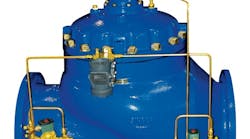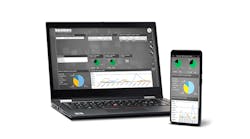"Ask the Experts" is moderated by Béla Lipták, process control consultant and editor of the Instrument Engineer's Handbook (IEH). If you would like to contribute to the 5th edition, currently in preparation, by updating an existing or by preparing a new chapter or if you have questions for our team of "experts," please write to me: at [email protected].
Q: Is there an intelligent control valve that can measure its own flow on the basis of its own pressure drop and opening? Did anybody evaluate/determine the accuracy/rangeability of such a "flowmeter"? Do you know any suppliers?
Harry Crowney
[email protected]
A: Years ago, I experimented with measuring the ΔP across regular control valves, and at the same time detecting the position of the plugs, and, based on these inputs, calculating the approximate flow. Theoretically, this is feasible because this configuration is the same as that of a variable orifice meter—one that is badly installed (not provided with sufficient straight runs up and downstream). I made such installations only when I did not need good accuracy, only good repeatability and rengeability at a low cost. I recall that most of these installations met these goals.
I also know that both Valtek and Singer markets such valves, but I have no experience with them, so I have no knowledge of their performance.
Similar to using control valves to indirectly measure flow, I also used pump and compressor curves to approximate gas and liquid flows at different discharge pressures without spending the money to buy regular flowmeters. These systems also gave reasonable repeatability and rangeability. As to accuracy, they too were inaccurate, and their performance much depended on the precision of the characteristic curves and the reliability of the manufacturer's testing.
Béla Lipták
[email protected]
Figure 1. The hydraulically operated Singer electronic flow control and metering system.
A: Valtek (Flowserve) sells a "StarPac" package that is both a positioner and a flow controller. The flow is available as a 4-20mA output, and you send the valve a setpoint. I don't represent the product or have any ties to the organization, but I do have a client up in Connecticut that was having problems getting a good steam flow signal to their batch reactor, and the Starpac valve seemed to work well for them. I don't know what kind of accuracy they claim, but it was repeatable enough for this client's application.
Here's a link to their website. www.flowserve.com/Products/Automation/Positioners-Digital/StarPac-3,en_US.
P. Hunter Vegas
[email protected]
A: I will share with you our experience in this regard. Our company manufactures large valves that bypass the flow of turbines to the condensers or steam to the process. In this application, water is injected into a de-superheater at the valve outlet to cool the steam prior to admission into the condenser or exporting the steam to the process. The required water flow rate is determined from the heat balance and the continuity equation. The steam flow rate must be measured or estimated in order to determine the correct water flow rate. It is quite common to use the bypass valve position to establish the steam flow rate. The valve supplier provides a flow versus stroke curve or an equation for calculating that relationship to the controls engineer, who uses this to program the spray water algorithm.
If the control valve is used as a flow measurement device, than it is a good idea to have the valve supplier conduct flow tests to establish accuracy of the flow vs. stroke curve. I believe that ISA S75.11 specifies a tolerance at approximately ±10%. I know from experience that a precision of ±5% is feasible if some additional care is taken in the design and manufacture of the valve. It is normal practice in nuclear plants to use the feedwater control valve opening as an indication of plant load, and to specify ±5% accuracy for the valve trim characteristics. This accuracy is achieved by testing, modification and retesting of the control valve trim.
Stephen Freitas
[email protected]
A: Flowserve have had such a device for a decade; the current StarPac 3 claims ±2% of full scale over approx. 30:1 turndown of the valve. See www.flowserve.com/files/Files/Literature/ProductLiterature/FlowControl/Valtek/VLENBR0066.pdf .
Ian H. Gibson
[email protected]
A: At least 10 years ago, Valtek was selling such a valve. I have never used one, nor have I ever talked to a user who had them installed, so I can't offer an opinion on them—but the theory is sound.
Walt Boyes
[email protected]
A: There is one, the Valtek StarPac II Intelligent Control System. It has a limited capability to measure flow inside the valve body. I would not expect such as system to be as accurate as a separate flow measurement, however.
For reference, see www.flowserve.com/files/Files/Literature/Products/Flowcontrol/Valtek/vlatb042.pdf.
Dick Caro
[email protected]
A: Valtek (now Flowserve) started making a "smart valve" 20 years ago. The current generation of the system has embedded pressure and temperature sensors that allow it to internally calculate flow rates.
Ken Beatty
[email protected]
A: Flowserve's patented "StarPac-3" intelligent control valve is capable of flow measurement, PID control and diagnostic functionality. You may paste the following link into your browser to download literature for more information: www.flowserve.com/files/Files/Literature/ProductLiterature/FlowControl/Valtek/VLENBR0066.pdf.
Fred Cain
[email protected]
A: I recently run across this very thing. It is a Singer Valve accessory (www.singervalve.com/Products/ElectronicControl/1062scmv2062scmv.html). I don't see any specifications on accuracy, though I suspect it is only as good as an orifice plate flowmeter.
Curt Wendt
[email protected]
Figure 2. FlowServe's StarPac 3 Intelligent Control System is another solution to the problem.
A: I used temperature and pressure data at two different times to measure hydrogen leaks in a closed generator system in power plants. When there was no leak, the ratios of (P/T) should be the same at two different times, where both P and T are in absolute values, and the time duration is on the order of 10 hours. When there was a leak, the leak rate was calculated to be (V/R) [(P1/T1) – (P2/T2)] / (t2 – t1) in moles per hour, where (t2 – t1) is the elapsed time, since the volume, V, of the system is constant and the gas constant R, is also constant. For generators, hydrogen leaks are normal, so long as the expression [(P1/T1) – (P2/T2)] / (t2 – t1) is consistent after the casing is put back on each time.
Valtek StarPac control valve has a temperature and a pressure sensor in it, but has no flow sensor. Such a valve has been successfully applied in severe service applications for monitoring both the temperature and the pressure of the process fluid where conventional temperature and pressure tapping points failed.
Gerald Liu, P.Eng.
[email protected]




